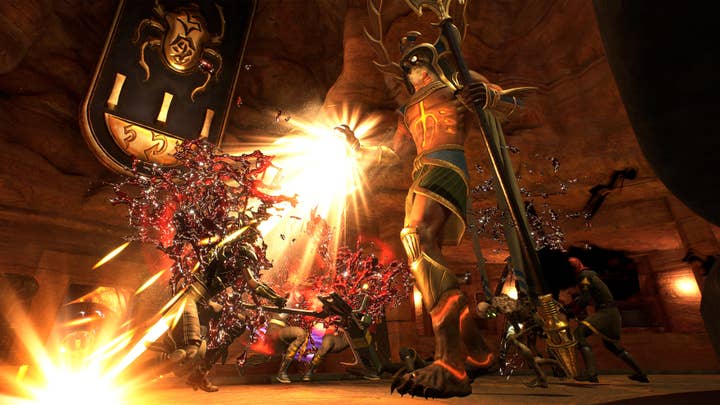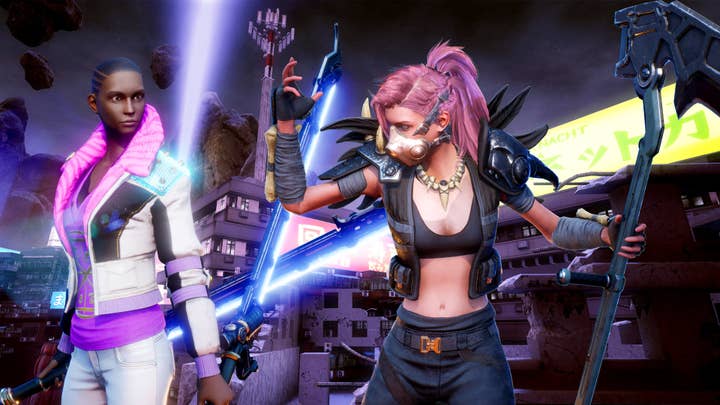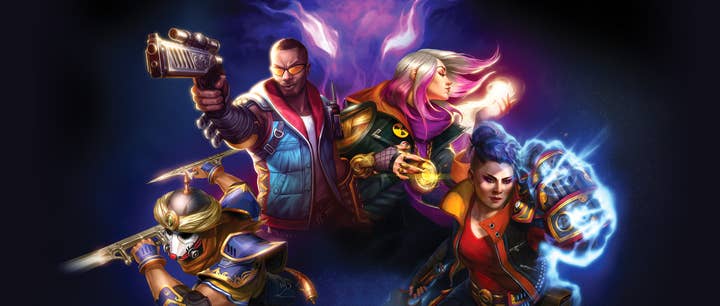The Dungeon Master fantasy: Designing asymmetrical multiplayer in Breach
QC Games boss Dallas Dickinson discusses balancing the different tools and strategies that let players tell new stories with every match
Multiplayer is the driving force behind many a successful game, and over time developers have trended towards creating as level a playing field as possible to appeal to a broader audience.
Look at Clash of Clans or Clash Royale, where the might of your army is as much a sign of time invested as it is player skill. Or better yet, look at the rise of battle royale -- all 100 people who skydive into Fortnite begin each match on exactly the same footing: no weapons, no resources (as opposed to the superior loadouts higher-skilled Call of Duty players spawn with).
So a game where four players face off against one -- and that one cannot be killed -- might seem like a tougher sell. Nevertheless, that's what the ex-BioWare devs at QC Games are attempting with Breach.
The title is an online dungeon crawling affair, where a party of four heroes raid a series of seven rooms -- six with various challenges, the seventh with a boss fight. Attempting to stop them is the immortal Veil Demon, controlled by a fifth player, who can trigger traps, spawn enemies and otherwise hinder the heroes' progress.
It's a fresh take on a little-explored concept of game design: asymmetrical multiplayer, where the two sides of the conflict are seemingly unbalanced. It was perhaps most prominently attempted with monster-hunting multiplayer shooter Evolve but, much like Turtle Rock's title, the idea has struggled to take off. So why is QC Games throwing its weight behind the notion now?

"It's because we love dungeon crawls and we love the dungeon master fantasy," president and CEO Dallas Dickinson tells GamesIndustry.biz. "The dungeon master is not actually your adversary, they are the creator of a narrative. They play with their party and the skills as well as the weird interactions between people. They'll make an encounter play out a certain way because they know it will cause conflict between two characters, and that's going to be fun.
"It's not quite at the story level, but in the narrative of a dungeon, that's what the Veil Demon is doing. When I play, I look to see what classes I'm up against -- and I look to see which of those players is the weak link, so I can isolate that person. If the party comes to rescue that person, I'm having fun kinda being a troll but I'm also making the game fun for them."
At the end of each match, players rate each other on whether they did a good job. To Dickinson, this means the win condition for the Veil Demon is not necessarily to beat the heroes but to challenge them, make each 15-minute match interesting, and be praised for it. QC is building other, more traditionally balanced modes -- including a four-plus-one vs four-plus-one -- but the core will be the aforementioned set-up.
That said, Dickinson says the team is trying to differentiate Breach's form of asymmetical multiplayer from those that have come before. Rather than Evolve's clear-cut four vs one matches, he likes to think of his own game as four vs a dungeon -- "and it just happens that there's one person affecting the way the dungeon plays out". This also makes it easier to balance the two sides, he says.
"I look to see which of those players is the weak link, so I can isolate that person. I'm having fun kinda being a troll but I'm also making the game fun for [the other players]"
"In Evolve, once you kill that monster, the game is over and therefore the balance is really hard to do. There are all sorts of aspects of that which make it a tough sell for players. I think the games that do better are things like Dead By Daylight, where the win conditions are really difficult for both sides. You're not actually trying to kill this thing, you're just trying to get away from it. We love to see what those games do because they go a little bit closer to the sort of thing we're trying to do.
"We think we've found a way that makes it work, that makes it different, but also not feel like it's unbalanced."
QC Games aren't the first that have tried. In fact, the concept sounds rather similar to Xbox's cancelled Fable Legends, which also saw a dungeon master meddling in the adventures of four heroes -- albeit without the ability to enter the dungeon and fight them directly.
There are great examples of how asymmetry can create entertaining mulitplayer challenges that are different every time. Wii U launch title NintendoLand featured three: Mario Tag, Luigi's Ghost Mansion and Animal Crossing: Sweet Day. The latter in particular has proven itself to allow the sort of emergent gameplay Breach is hoping to thrive on -- certainly in the Batchelor household.
In one match against two of my friends were grabbing a few sweets at a time and dumping them on an island, in order to avoid becoming overencumbered and easier to catch. Their plan was to gather all the sweets on the map and gobble them up at once for an instant win -- but the island they had stashed them on had only two bridges to access it. And I controlled two guards.
It's the sort of scenario you just wouldn't find yourself in with the standard deathmatch formula that's dominated multiplayer design for decades, so why haven't more developers explored this?

"My weird answer is that they actually have," says Dickinson. "I believe that's actually what is happening in battle royale games. The win condition is always the same, but the different paths to it and the different ways you can play, whether you're a dedicated group that plays together or the solo player who likes to lone wolf, actually creates the emergent gameplay that is the moment you're talking about.
"What you just described is a brilliant moment of someone coming up with what they thought was the optimal strategy, thought they had that shit on lock. But because the one thing they didn't expect -- that their strategy was discovered because they thought they'd done it in a weird, hidden way -- all of a sudden, the tables turned 100%, they were fucked because the guards could block the entrances and they had to figure a way around that... and I assume you eventually crushed them?"
"You already know you're doing something different from that player so what other weird things can you try out? You wouldn't be doing that if you the rules were the same every time"
I did.
"The smaller and more restricted a PvP game is, the less opportunity there is for that."
Dickinson posits that this is one of the reasons why League of Legends succeeds where Heroes of the Storm hasn't. The latter strived to get away from the usual three-lane push you find in MOBAs but this inadvertently meant there was only a handful of winning strategies on each maps.
"So where they thought they were creating more variation and more opportunity for different types of gameplay, they actually did the opposite," Dickinson continues. "They created maps where you must do this thing in order to win. League's entire development process, from what I've seen, is every season they try to take what were the optimal strategies and offer one to four alternative strategies that might be ridiculously overpowered but also might not be, so that weird, crazy things might happen because that's where the joy of discovery and emergent gameplay comes out.
"I think asymmetry helps. When you set up a game where the goals for each side are exceedingly different, finding the weird optimal paths... maybe in the psychology of the player, you already know you're doing something different from that player so what other weird things can you try out? What if you stick together in a group? What if you scatter to the wind? What if you go in groups of two? You wouldn't be doing that if you the rules were the same every time."

Dickinson says he often suggests new ideas for Breach but his designers knock them back because they would create an optimal strategy for certain rooms in each dungeon, thus unbalancing it.
Each room in Breach has a different objective, whether it's killing waves of enemies or holding capture points for a certain time, and so on. While the Veil Demon cannot be killed, and has powers to prevent heroes from accomplishing their goals, it is never overpowered. In fact, there are so many variations of Veil Demon that each one only has advantages in certain rooms -- for example, in a chamber where players have to kill standard enemies, the Veil Demon might be limited in their ability to stop them, but they can physically knock players off the capture points in the next room.
"As a Veil Demon, you can still win or lose any of those rooms, but the advantages change and that changes the way you play tactically," Dickinson explains. "You might let players win a room to save your special skills for the next one. You might let them think they're winning until they reach a room or a point where you can crush them.
"Some people don't play that way, they don't isolate one and try to pick the rest off. Some people try to synchronise lots of shit at once so they can pop three heroes in one go. From the party's point of view, it's a one-shot kill but it's because the Demon player planned it out and went through four or five steps to get there. We give such a deep toolkit to both the hero side and the Veil Demon side that this emergent stuff is available to them."
Ultimately, designing asymmetrical multiplayer well comes down to balance -- and the structure of Breach gives QC Games a very clear way to measure this: whether or not the heroes reach the boss room.
"If 90% of the time people get to the boss room, but those fights go 50-50, that's our ideal," Dickinson concludes.









